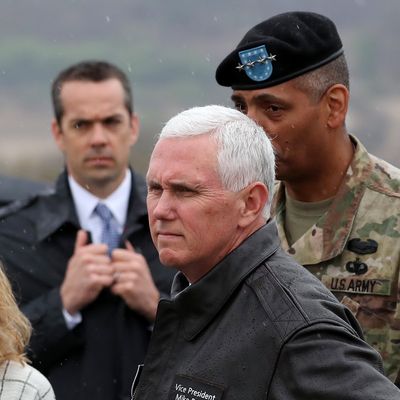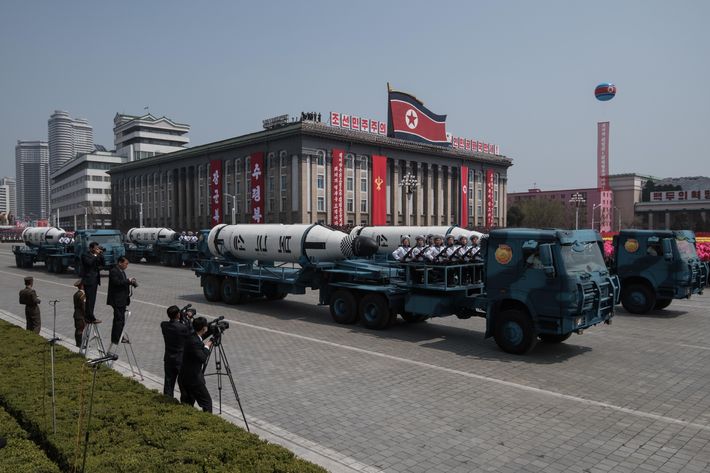
North Korea did not celebrate its founder’s birthday on Saturday by testing a new nuclear weapon, as many had feared it would. Instead the North Korean regime literally paraded its missiles through Pyongyang, including new intercontinental ballistic missile (ICBM) systems that arms experts had never seen before. North Korea conducted a missile test on Sunday, but it failed, according to military officials in the U.S. and South Korea. It was likely a medium-range missile, which exploded almost immediately after launch.
Defense Secretary James Mattis responded to the launch on Saturday night (U.S. time), seemingly speaking for the president and White House.“The president and his military team are aware of North Korea’s most recent unsuccessful missile launch,” he said in a statement. “The president has no further comment.”
A White House official told the New York Times that while President Trump has many options available, he probably won’t respond to North Korea’s failed missile launch. “If it had been a nuclear test, then other actions would have been taken from the U.S.,” the official said.
Vice-President Mike Pence called the test a “provocation” when he arrived in South Korea on Sunday at the start of a four-nation Asia tour. Then, during a surprise visit to the Demilitarized Zone on Monday, Pence called the U.S. alliance with South Korea “ironclad,” and said North Korea “should not mistake the resolve of the United States of America to stand with our allies.”
“[T]he era of strategic patience is over,” Pence said. “President Trump has made it clear that the patience of the United States and our allies in this region has run out and we want to see change. We want to see North Korea abandon its reckless path of the development of nuclear weapons, and also its continual use and testing of ballistic missiles is unacceptable.”
Sunday’s missile test was North Korea’s fifth of the year. The reason it blew up is unknown, but such failures are a regular outcome for the regime. The Times reported that the U.S. began conducting a covert electronic war against North Korea’s missile program three years ago, though the extent of its success is not clear. President Obama apparently accelerated the program last year, and the Times notes that there has been a corresponding increase in the failure rate of North Korea’s tests since then.
The large collection of missile systems displayed during Saturday’s parade in Pyongyang still alarmed arms and nonproliferation experts. There were both new configurations of existing missile systems, as well as what appeared to be two new canister ICBM launching systems that may have held new ICBMs.
Whatever the canisters contained, the regime was clearly trying to demonstrate that, as it has repeatedly promised, it is developing long-range intercontinental ballistic missiles that are capable of hitting the U.S., as well as missiles that utilize solid-fuel technology, which would enable North Korea to more easily transport and hide its missiles and launch them with less warning to international monitors.
Ultimately, the regime is trying to convince the world that it possesses second-strike capability, or will soon — which means that it would be able to respond to any first strike on North Korea with a devastating counterattack on the U.S. or its allies in the region, possibly including a nuclear-weapon payload.
Some experts warn that appearances can be deceiving, especially when it comes to North Korea. For instance, it’s possible that the country was only displaying mock-ups of new ICBM systems on Saturday, rather than the functioning, or near-functioning, weapons themselves.
Regardless, analysts seem to agree that the world should be concerned about what Saturday’s parade said about North Korea’s gains and goals. Even if the regime was only displaying mock-ups, they show what North Korea intends to build, and that the government has made progress toward that aim. As one surprised nonproliferation analyst commented in response to the parade:
Another expert, Duyeon Kim, explained to the Japan Times that North Korea’s missile pageant was meant to send “a message to its own citizens and the international community that the regime is ‘powerful,’ has made ‘leaps’ in technological advancements and will not cave under U.S. pressure.”
In an interview with NPR, Jeffrey Lewis, director of the East Asia Nonproliferation Program at the Middlebury Institute of International Studies, added:
I think in the United States we sort of laugh at [the North Korean regime]. We treat them like they’re a little bit of a joke, but they don’t think they’re a joke. And I think the North Koreans long ago concluded that their weapons programs are a way of getting us to take them seriously. And so I think a lot of times, we have expectations for the North Koreans, and the North Koreans like to defy those expectations. They like to show us that they’re serious about this, that they really can do this and that if there is a joke, it’s on us, not them.
In Lewis’s opinion, the regime may have shown as many as three new ICBM systems on Saturday, and the overall demonstration was “bewildering” to him and other experts. While there have been many stumbles along the way, North Korea has continued to develop the weapons technology they see as integral to their survival.
On the other hand, the regime has never successfully tested a long-range ICBM that could reach the U.S. It’s unclear if the regime has been able to build a nuclear warhead small enough to mount on a missile or to survive reentry from space.

Aside from the new ICBM canisters, many of the rocket and missile systems on display during the parade on Saturday did not appear to be new; some were just variations of older models, or weapons that had been reconfigured or cosmetically altered. The regime unveiled two solid-fuel missiles, which have been tested but never before seen: a submarine-launched ballistic missile (with an intermediate range of 600 miles) that the country tested last year, and a similar land-based version that the North Koreans launched into the Sea of Japan in February. Most of North Korea’s missiles run on liquid fuel, which means they have to be fueled before firing, making the launches slower and missile systems easier to detect. Solid fuel missiles are preloaded and ready to fire, require a smaller fleet of support vehicles, and can be stored on submarines or easily hidden mobile launchers.
Amid the still-heightening tensions between North Korea and the U.S., The Diplomat’s Ankit Panda sees the new missile systems, whether they are ready to use or not, as an ominous development:
[M]ore so than ever, North Korea seems to be highlighting the perils of a preemptive first strike to the United States and South Korea. With every nuclear and ballistic missile test, its threat of inflicting unacceptable retaliatory damage against Seoul and, eventually, Washington becomes more credible.
What’s more, we’re likely still in for a sixth nuclear test sooner or later. Even though Pyongyang withheld from testing this weekend amid rumors of possible retaliation by the United States, North Korea is still looking to improve its missile know-how. Moreover, the long-dreaded ICBM flight test also might not be too far off now. Given the ever-growing number of TELs — both wheeled and tracked — North Korea may soon field nuclear forces amply large that a conventional U.S.-South Korea first strike may find it impossible to fully disarm Pyongyang of a nuclear retaliatory capability. That would give the North Korean regime what it’s always sought with its nuclear and ballistic missile program: an absolute guarantee against coercive removal.
This post has been updated throughout.






























